First impressions shape enrollment decisions. When prospective families walk through your campus—or explore it virtually—the experience either reinforces their interest or raises doubts about fit. Traditional guided tours provide valuable personal interaction, but they’re limited by staff availability, tour guide knowledge, and the inability to showcase everything a school offers in 60-90 minutes.
Whether you’re an admissions director seeking to modernize recruitment, a principal looking to showcase your school more effectively, or a facilities manager planning campus improvements, this comprehensive guide explores how digital tour technologies transform prospective family experiences while improving operational efficiency.
Understanding Digital School Tour Solutions
Digital school tours encompass a range of technologies that supplement or replace traditional guided campus visits. Rather than a single solution, effective digital touring combines multiple elements creating comprehensive experiences that serve different visitor needs and preferences.
Core Components of Modern School Tours
Interactive Wayfinding Displays: Touchscreen kiosks positioned throughout campus enable self-guided exploration without requiring tour guide availability. Visitors tap locations of interest—classrooms, athletic facilities, performing arts centers—and receive directions, facility information, and historical context about that area.
Modern wayfinding systems go beyond simple maps. They showcase recent renovations, highlight unique programs housed in specific buildings, and provide multimedia content about facilities that bring spaces to life. When prospective families arrive during off-hours or without appointments, these displays ensure they can still explore meaningfully rather than simply walking past locked buildings.

Digital Recognition Displays: Strategic placement of interactive achievement displays throughout tour routes transforms passive building tours into engaging storytelling experiences. Rather than tour guides verbally describing accomplishments, families interact directly with digital content showcasing:
- Academic excellence through National Merit Scholars, valedictorians, and competition achievements
- Athletic success via championship histories, record holders, and college commitment tracking
- Fine arts accomplishments including performance highlights and competition results
- Distinguished alumni demonstrating long-term educational value
These displays validate institutional quality through concrete evidence rather than marketing claims. When prospective parents see dozens of college commitments or decades of academic excellence documented comprehensively, it builds confidence that exceeds any verbal description.
Virtual Tour Platforms: Not all interested families can visit in person. Distance, scheduling conflicts, or pandemic concerns make physical visits impractical for many prospective students. Virtual tour options extend recruitment reach while providing convenient preview experiences for families determining whether in-person visits warrant the time investment.
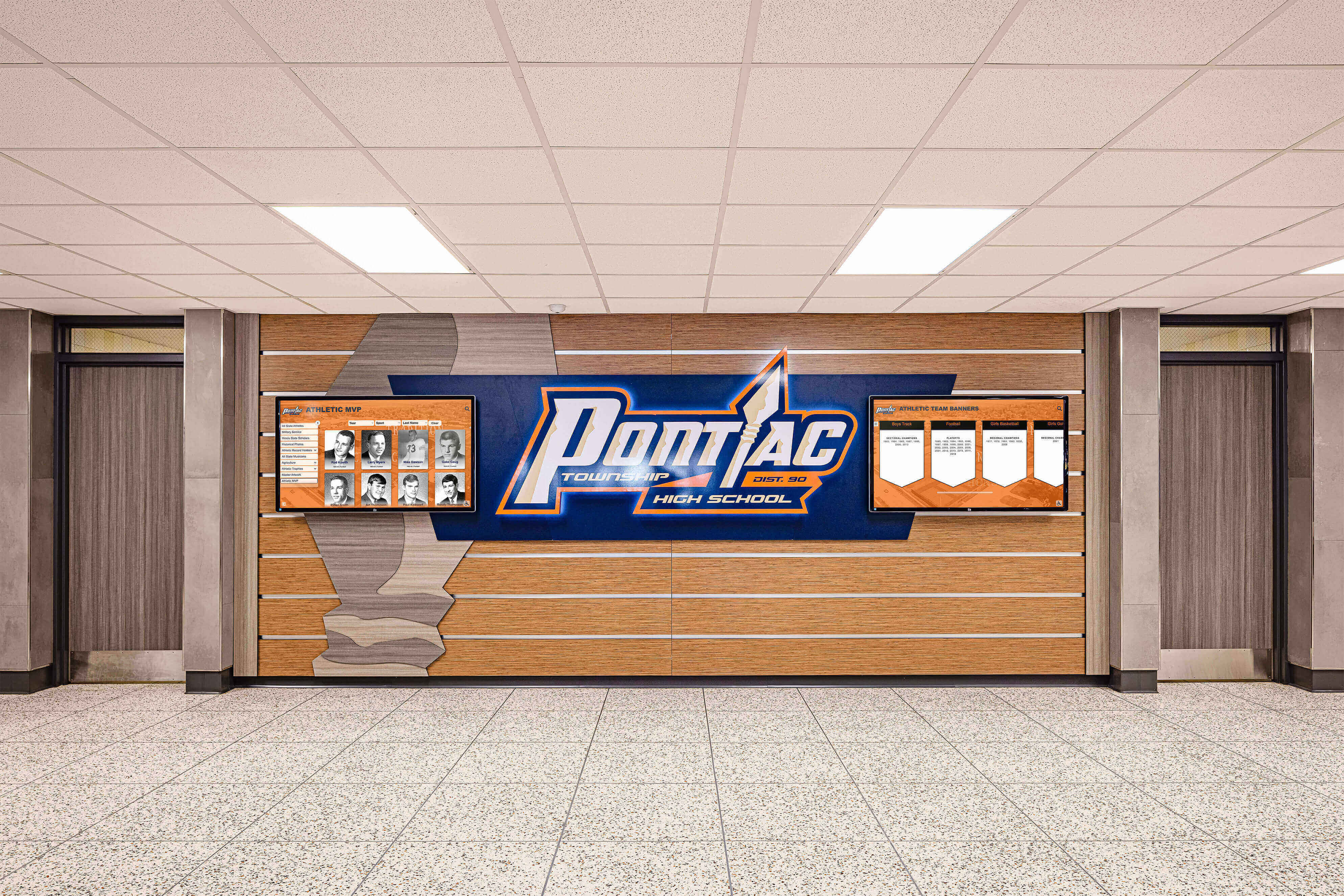
Effective virtual tours include:
- 360-degree photography or video walkthroughs of key facilities
- Narrated content explaining unique program features and facilities
- Interactive elements allowing viewers to explore at their own pace
- Integration with admissions portals for scheduling follow-up visits
- Mobile optimization ensuring accessibility on smartphones and tablets
Self-Serve Information Kiosks: Placing information kiosks in school lobbies provides prospective families with comprehensive program details without requiring staff intervention. These displays answer common questions about academics, extracurriculars, athletics, admission requirements, and costs—information that families often seek before engaging directly with admissions staff.
Well-designed information kiosks reduce repetitive staff work while ensuring consistent, accurate information delivery. They also empower families who prefer researching independently before asking questions, respecting different decision-making styles.
Benefits of Technology-Enhanced Tours
Schools implementing digital tour solutions report multiple advantages that improve both visitor experiences and operational efficiency:
Expanded Accessibility: Traditional tours occur during business hours on weekdays, requiring parents to take time off work and students to miss school. Digital components enable meaningful exploration during evenings, weekends, or impromptu visits when families happen to be near campus. This flexibility particularly benefits working parents who struggle to visit during conventional tour times.
International families exploring boarding school options or families relocating from distant locations can conduct thorough initial evaluations without travel expenses. Virtual tours filter prospects effectively—families who visit in person after virtual exploration arrive more informed and genuinely interested.
Consistent Information Delivery: Student tour guides, despite training, provide variable information quality depending on their knowledge, enthusiasm, and presentation skills. Digital systems ensure every visitor receives comprehensive, accurate information about programs, facilities, and achievements regardless of which tour guide happens to be available or whether they’re visiting independently.

This consistency proves particularly valuable for competitive comparisons. When families visit multiple schools, consistent information presentation across all visits enables more accurate school-to-school evaluation rather than assessments influenced by tour guide charisma.
Staff Efficiency: Admission directors spend substantial time conducting repetitive tours covering identical information. Digital solutions handle routine information delivery, freeing staff to focus on relationship-building, answering specific questions, and addressing individual family concerns—higher-value activities that actually influence enrollment decisions.
Rather than eliminating human interaction, technology optimizes it. Staff members engage in meaningful conversations rather than reciting memorized facts about founding dates, graduation requirements, or facility capacities—information that digital displays present more effectively through multimedia content.
Enhanced Storytelling: Static photographs and verbal descriptions pale compared to video highlights of championship games, recorded performances from musical productions, or interactive timelines showing institutional evolution. Digital media brings school culture and achievements to life in ways that create emotional connections impossible through traditional touring methods.
Prospective students watching actual classroom footage, performance videos, or student testimonials form clearer pictures of daily life than any tour guide description provides. These authentic glimpses help families assess cultural fit—the intangible factor that often determines enrollment decisions more than facilities or programs.
Measurable Engagement: Digital systems track which information generates most interest—which programs families explore, how long they engage with content, what questions they search for most frequently. These analytics inform marketing strategies, identify overlooked program strengths worth emphasizing, and reveal information gaps in traditional communication materials.
Unlike traditional tours where families’ specific interests remain unknown unless explicitly stated, digital engagement data provides concrete evidence about what matters most to prospective families, enabling data-driven recruitment improvements.
Planning Your Digital Tour Implementation
Successful digital tour integration requires strategic planning that addresses technology selection, content development, and integration with existing admission processes.
Assessing Current Tour Experiences
Begin by honestly evaluating existing tour quality and identifying specific improvement opportunities:
Gather Stakeholder Feedback: Survey recent visitors about their tour experiences—what information was most valuable, what questions remained unanswered, what they wished they could have seen but didn’t due to time constraints. This feedback reveals gaps that digital enhancements can address.
Interview admission staff about repetitive questions, tour logistics challenges, and timing constraints. Understanding operational pain points helps prioritize technology investments that solve real problems rather than implementing solutions seeking problems.
Audit Tour Content: Document everything covered during typical tours—buildings visited, information shared, materials provided. Identify inconsistencies between tour guides or shifts in coverage based on visitor interests. This audit establishes content baselines and reveals standardization opportunities.
Map typical tour routes physically, noting viewing distances, lighting conditions, and accessibility considerations. These factors influence optimal placement for digital displays and wayfinding tools.
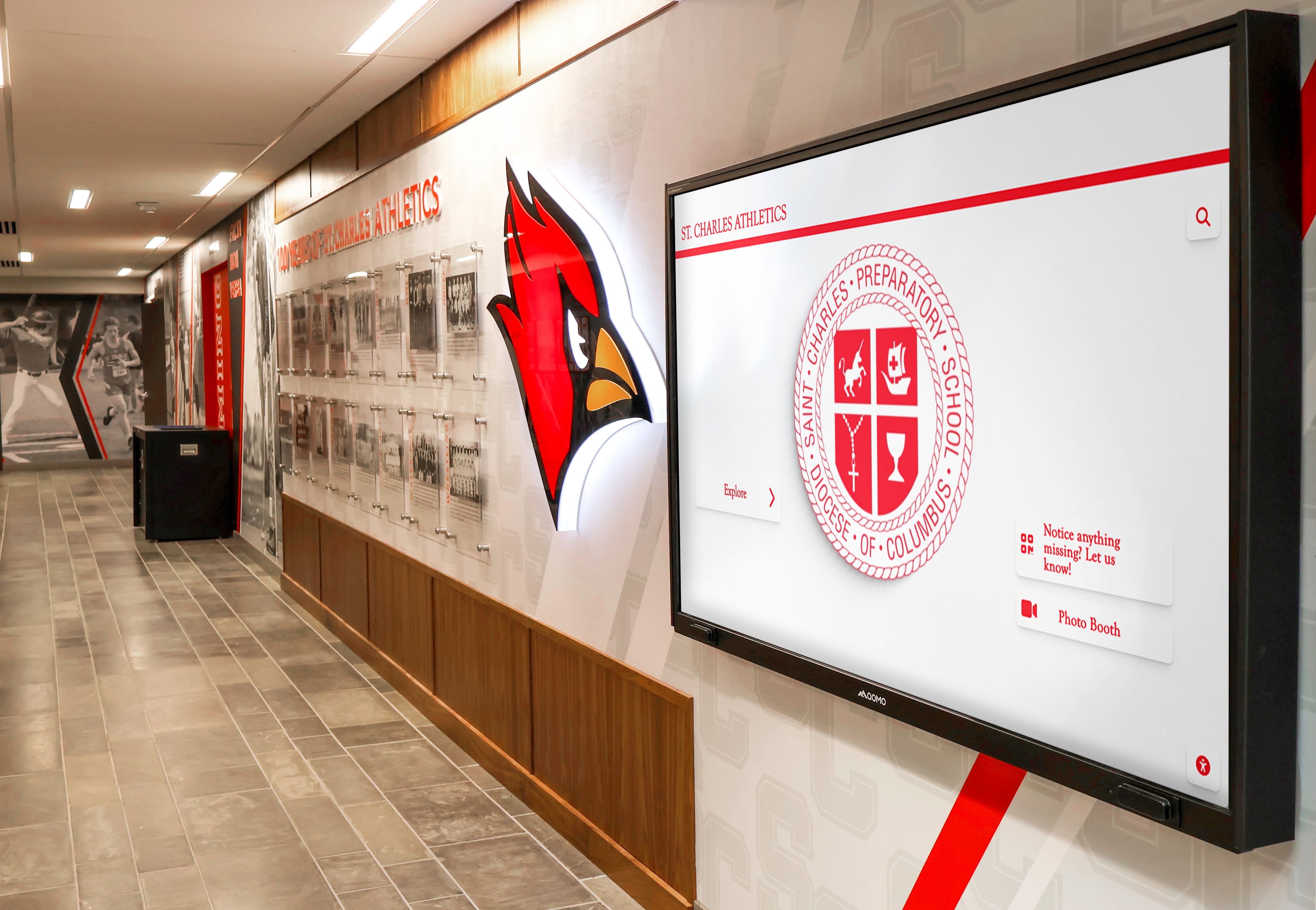
Analyze Visit Patterns: Track when prospective families visit—days of week, times of day, seasons. Understanding visit patterns identifies optimal times for scheduled tours versus self-guided digital experiences. Schools discovering most visitors arrive evenings or weekends benefit particularly from 24/7 digital access.
Review conversion rates from initial visit to application to enrollment. Low conversion despite high tour interest may indicate information gaps or misaligned expectations that digital content can address through more comprehensive, accurate institutional portrayal.
Defining Digital Tour Objectives
Clear goals guide technology selection and implementation approaches:
Primary Objectives:
- Extend reach to families unable to visit physically due to distance or scheduling
- Improve consistency of information delivery across all visits
- Enhance engagement through multimedia storytelling that creates emotional connections
- Increase efficiency by automating routine information delivery
- Support decision-making by providing comprehensive program and facility information
Success Metrics: Establish measurable targets allowing implementation evaluation:
- Increased virtual tour engagement (views, time spent, interactions)
- Higher conversion rates from inquiry to application or visit to enrollment
- Improved family satisfaction scores on post-visit surveys
- Reduced staff time conducting tours without decreasing tour quality
- Extended visitor exploration beyond guided tour duration
Technology Selection Considerations
Multiple technology options serve digital tour needs—choosing appropriate solutions requires balancing capabilities, budget, and maintenance requirements:
Interactive Touchscreen Displays: Commercial-grade touchscreens positioned strategically throughout campus provide intuitive wayfinding, program information, and achievement recognition. Key considerations include:
- Screen size appropriate for viewing distance (typically 43-75 inches)
- Touch technology supporting multi-user interaction
- Commercial durability rated for extended daily operation
- Content management systems enabling easy updates without technical expertise
- Integration capabilities with existing school data systems
Solutions like interactive building directories serve dual purposes—guiding daily visitors while enhancing prospective family tours.
Virtual Tour Software: Platforms enabling 360-degree tours, video integration, and interactive navigation require careful evaluation:
- Mobile responsiveness ensuring smartphone/tablet accessibility
- Loading speed preventing visitor frustration
- Integration with admission CRM systems for lead tracking
- Analytics providing engagement insights
- Cost structure including hosting, updates, and support
Digital Signage Systems: Display screens in high-traffic areas showcase rotating content about programs, achievements, and current events. Consider:
- Content scheduling allowing targeted messages by time/date
- Remote updating capabilities
- Professional design templates ensuring polished presentation
- Integration with social media or other content sources
- Resolution appropriate for viewing distance
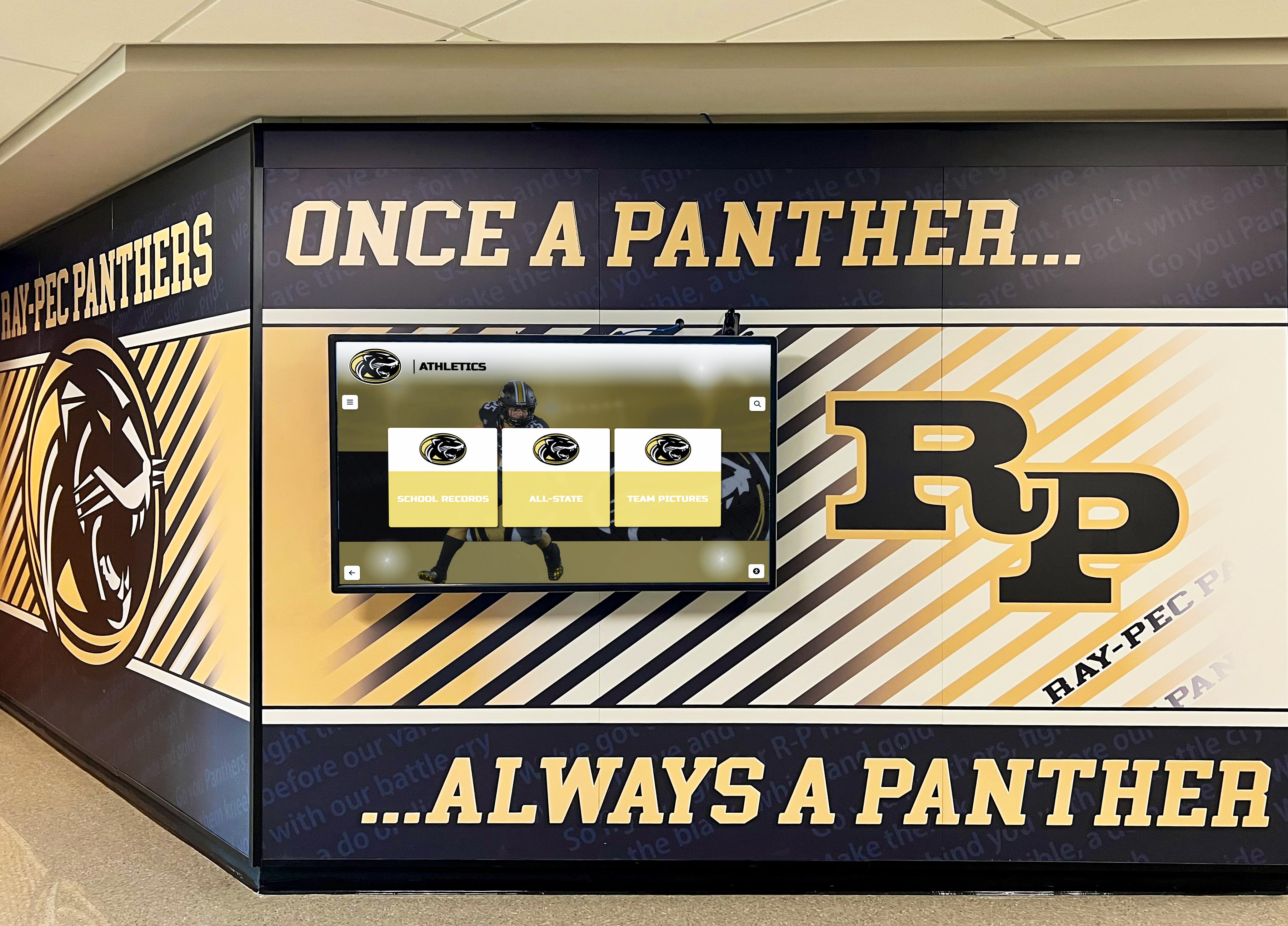
Mobile Tour Apps: Smartphone applications guiding self-directed tours offer flexibility but require higher development investment. Evaluate:
- Development costs versus web-based alternatives
- Maintenance requirements for iOS and Android versions
- User adoption likelihood (will families download?)
- Offline functionality for areas with weak connectivity
- GPS integration for location-aware content delivery
Many schools find web-based mobile tours more practical than dedicated apps—they require no downloads, work across all devices, and typically cost less to develop and maintain.
Content Development Strategy
Technology provides delivery mechanisms, but compelling content determines tour effectiveness. Strategic content development ensures digital tours engage effectively:
Core Content Categories:
- Facilities information: Building purposes, recent renovations, capacity, special features
- Academic programs: Course offerings, special programs, teaching approaches, student outcomes
- Extracurricular activities: Clubs, organizations, athletics, arts programs
- Student life: Daily schedules, traditions, support services, campus culture
- Achievement recognition: Alumni success stories, awards, championships, academic honors
Multimedia Integration: Effective digital content mixes formats creating engaging experiences:
- Professional photography showcasing facilities, activities, and student life
- Video clips featuring student testimonials, classroom footage, and event highlights
- Audio narration providing context and storytelling where appropriate
- Interactive maps enabling exploration at visitor pace
- Searchable databases allowing specific information lookup
Voice and Tone: Digital content should feel authentic rather than promotional. Student voices, genuine experiences, and honest portrayals build trust more effectively than marketing hyperbole. Families appreciate transparency about challenges alongside strengths—it demonstrates institutional self-awareness and integrity.
Consider featuring actual students, teachers, and parents sharing unscripted perspectives. These authentic voices resonate more powerfully than scripted marketing messages, helping families envision themselves as part of school community.
Implementing Digital Tour Technologies
Successful implementation transforms planning into operational reality through systematic deployment, training, and integration.
Strategic Display Placement
Location determines digital tour element visibility and effectiveness:
Primary Tour Starting Points: Position comprehensive interactive displays in main entrances and admission offices where tours begin. These become digital tour guides providing overview information, facility maps, and navigation assistance that supplement human guidance or enable self-directed exploration.
High-Traffic Corridor Locations: Place achievement recognition and program highlight displays along commonly-traveled paths connecting buildings. These create discovery moments during transit between tour destinations, extending engagement beyond specific facility viewing.
Facility-Specific Installations: Install content-specific displays near relevant facilities—athletic achievements near gymnasiums, performing arts highlights near theaters, historical timeline displays near original campus buildings. This contextual placement makes information immediately relevant to visible surroundings.
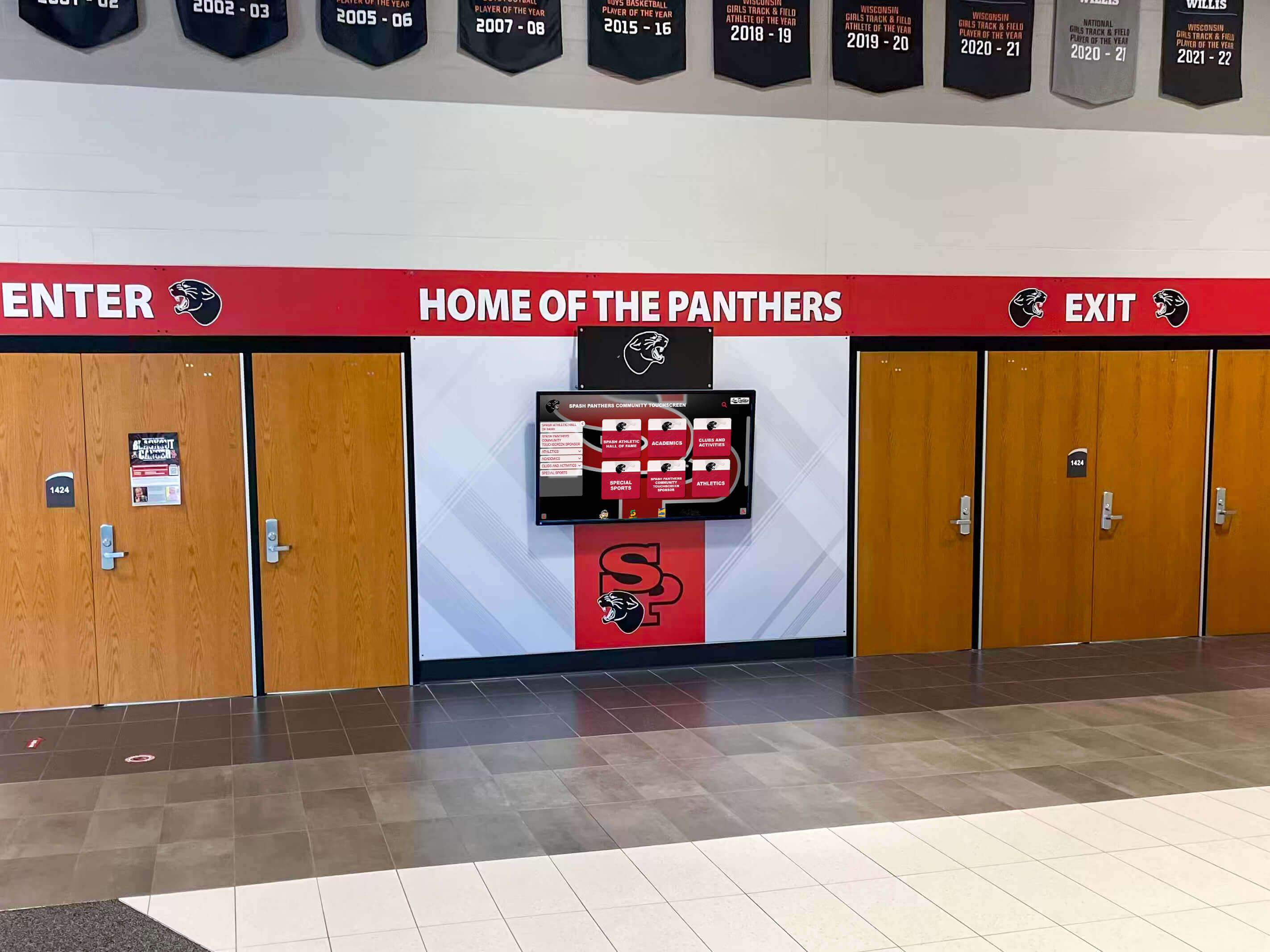
Waiting Area Engagement: Transform waiting time in admission offices into engagement opportunities through strategically-placed displays showing rotating content about programs, student achievements, and campus life. Families naturally explore when waiting, making these placements highly effective for information delivery.
Staff Training and Integration
Technology succeeds only when staff embrace and actively incorporate it into admission processes:
Tour Guide Preparation: Train tour guides on digital system capabilities so they can confidently reference and demonstrate displays during guided tours. Rather than viewing technology as replacement, guides should present it as enhancement—showing families how to independently explore topics of specific interest after tours conclude.
Provide guides with talking points connecting digital content to physical spaces: “The touchscreen near the entrance shows all our state championship teams—you’ll see it when we walk back through” creates anticipation and encourages post-tour engagement.
Admission Staff Orientation: Ensure all admission personnel understand system capabilities, can troubleshoot basic issues, and know how to leverage digital tools during family conversations. Staff should comfortably navigate virtual tours on tablets during meetings, quickly pull up specific program information on kiosks, or send families links to online content addressing their questions.
Create quick-reference guides for staff covering common questions, content locations, and basic troubleshooting. This removes uncertainty that might prevent system utilization.
Maintenance Protocols: Establish clear responsibility for content updates, hardware cleaning, and issue reporting. Regular maintenance prevents displays from appearing neglected—dirty screens or outdated content undermine rather than enhance institutional perception.
Schedule quarterly content reviews ensuring information accuracy, adding recent achievements, updating photos reflecting current students, and refreshing featured content preventing staleness.
Launch Strategy
Thoughtful rollout maximizes adoption and initial impact:
Soft Launch Testing: Begin with limited deployment, testing systems with internal stakeholders before full public launch. Gather feedback from staff, current students, and friendly alumni about functionality, content clarity, and navigation intuitiveness.
This testing phase reveals issues best addressed before prospective families encounter them—confusing navigation, missing content, or technical glitches that undermine professional impression.
Phased Expansion: Rather than attempting comprehensive implementation simultaneously, deploy in phases:
- Phase 1: Primary entrance welcome display and admission office information kiosks
- Phase 2: Key facility-specific displays (athletics center, performing arts building)
- Phase 3: Corridor recognition displays and extended content
- Phase 4: Virtual tour launch and mobile optimization
Phased implementation distributes costs, allows learning from each phase, and prevents overwhelming content development or staff training requirements.
Communication and Promotion: Actively promote digital tour capabilities to prospective families through:
- Website prominent featuring of virtual tour options
- Admission email sequences highlighting self-guided exploration possibilities
- Social media showcasing display content and virtual tour screenshots
- Open house announcements emphasizing 24/7 accessibility
- Follow-up communications encouraging virtual re-visits to specific content
Many families won’t automatically notice or utilize digital options without explicit encouragement. Proactive promotion ensures technology investments achieve their engagement potential.

Creating Compelling Digital Tour Content
Technology delivers content, but quality determines whether visitors engage meaningfully or dismiss displays as empty showpieces.
Storytelling Through Achievement Recognition
Digital displays positioned throughout tour routes transform simple facility viewing into inspiring storytelling opportunities:
Athletic Excellence Showcases: Rather than generic descriptions of athletic facilities, interactive record boards demonstrate competitive success through concrete evidence. Prospective student-athletes exploring championships, records, and college commitments form clear pictures of program quality and development opportunities.
Include video highlights of championship moments, coach interviews explaining training philosophies, and athlete testimonials about their development. This multimedia approach creates emotional connections that facility tours alone cannot achieve.
Academic Achievement Displays: Showcase National Merit Scholars, valedictorians, competition winners, and college acceptance outcomes through searchable databases families can explore by graduation year, achievement type, or college destination. This transparency about academic outcomes addresses primary parent concerns about educational quality.
Feature student academic journey narratives—students describing challenging courses, supportive teachers, and preparation for college success. These first-person accounts resonate more authentically than institutional marketing claims.
Fine Arts Recognition: Performance videos, competition results, and alumni pursuing arts careers demonstrate program strength through tangible evidence. Many schools inadequately showcase fine arts during tours because performances don’t occur on demand—digital content solves this limitation.
Include gallery-style displays of visual arts achievements, recorded musical performances, theatrical production highlights, and student artist profiles. This comprehensive documentation validates fine arts as institutional priority comparable to athletics and academics.
Alumni Success Stories: Distinguished alumni displays demonstrate long-term educational value through graduate success across diverse careers. When prospective families see alumni achieving in fields their children aspire to, it validates that the school prepares students effectively for those paths.
Feature “where are they now” updates showing career progression, graduate testimonials about school preparation, and alumni advice for current students. These connections between past and present create confidence about future outcomes.
Facility and Program Information
Beyond achievements, comprehensive program and facility information helps families evaluate fit:
Academic Program Details: Detailed course catalogs, teaching approach descriptions, and program-specific outcomes (AP test results, graduation requirements, unique offerings) address parent concerns about academic rigor and appropriate challenge levels.
Include teacher profiles featuring education backgrounds, teaching philosophies, and subject passions. Families choosing schools based on teacher quality appreciate this transparency that traditional tours rarely provide.
Extracurricular Opportunities: Comprehensive club listings, participation requirements, meeting schedules, and recent activities demonstrate breadth of opportunities. Many students choose schools based on specific extracurricular interests—comprehensive information allows assessment of program strength in those areas.
Feature student organization leaders discussing their experiences and welcoming prospective members. These peer perspectives often influence student enthusiasm more than adult descriptions.
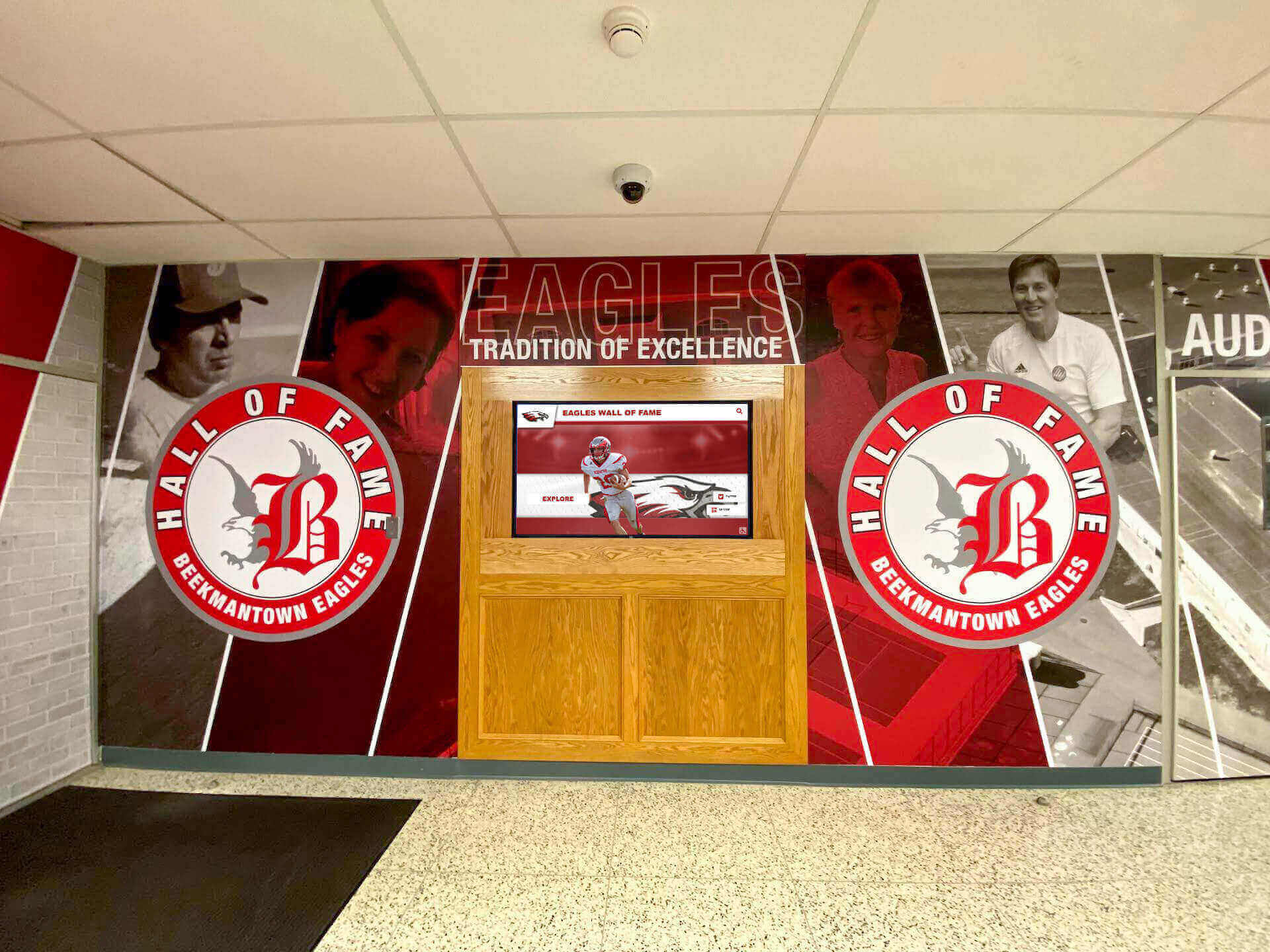
Facilities and Resources: Detailed facility information including capacities, recent renovations, specialized equipment, and unique features demonstrates investment in student experience. Families noticing modern technology, well-maintained spaces, and specialized facilities form positive impressions about institutional resources and priorities.
Include “day in the life” content showing how students actually use facilities throughout typical days. This contextual information helps families envision daily experiences rather than just seeing empty spaces during tours.
Student Support Services: Information about counseling, learning support, college advising, health services, and other resources addresses parent concerns about holistic student support. Comprehensive service information differentiates schools viewing students as complete individuals requiring varied support from those focused narrowly on academics alone.
Creating Accessible Virtual Tours
Virtual tours extend school reach to families unable to visit physically, but quality determines whether these replace or supplement in-person visits:
Comprehensive Coverage: Effective virtual tours include:
- All major facilities including classrooms, laboratories, libraries, athletic facilities, performing arts spaces, and common areas
- Multiple viewpoints within key locations showing facility scale and features
- Contextual narration explaining facility purposes and unique characteristics
- Student activity footage bringing spaces to life rather than showing empty rooms
- Seasonal variation acknowledging different times of year showcase different experiences
Navigation Intuitiveness: Virtual tour platforms should enable easy exploration without requiring instructions. Clear navigation icons, logical flow between locations, and “you are here” indicators prevent visitor confusion and frustration.
Include both structured tour options following recommended sequences and free exploration modes allowing visitors to jump directly to specific areas of interest. Different families prefer different approaches—accommodate both preferences.
Mobile Optimization: Many families explore virtual tours on smartphones or tablets rather than computers. Ensure platforms work smoothly on mobile devices with appropriate touch controls, reasonable data usage, and optimized loading for cellular connections.
Test virtual tours on various devices and connection speeds ensuring accessibility regardless of family technology resources. Visitors accessing from older devices or slower connections deserve equally positive experiences.
Integrating Digital Tours with Admission Processes
Digital tour technologies succeed when seamlessly integrated into broader admission workflows rather than existing as isolated enhancements:
Lead Capture and Follow-up
Technology creates engagement tracking opportunities improving follow-up communication:
Virtual Tour Registration: Require email registration before virtual tour access, capturing leads even when families aren’t ready for in-person visits. This early contact enables nurture sequences that maintain engagement through decision-making processes.
Request information about grade level, specific interests, and visit timeline during registration. This data enables personalized follow-up addressing family-specific priorities rather than generic mass communications.
Engagement Analytics: Track which virtual tour sections families explore most extensively, how long they engage, and whether they return for multiple viewings. These behaviors indicate interest levels and priorities informing personalized follow-up conversations.
When admission counselors know families extensively explored athletic facilities or repeatedly viewed specific academic programs, conversations can address those specific interests rather than covering everything generically.
Automated Follow-up Sequences: Trigger email sequences based on virtual tour completion, addressing common questions, sharing additional resources about explored programs, and encouraging in-person visits or application submission.
Include clear next-step calls-to-action—schedule campus visit, attend open house, submit inquiry form, or begin application. Technology engagement creates warm leads requiring clear conversion paths toward enrollment.
Supplementing Guided Tours
Digital elements enhance rather than replace human interaction:
Pre-Tour Preparation: Send virtual tour links before scheduled visits, encouraging families to explore independently first. This preparation enables families to arrive with specific questions rather than using valuable tour time covering basic information accessible digitally.
Include pre-visit surveys asking which programs or facilities interest them most. This intelligence allows tour customization focusing on family priorities rather than covering everything generically.
During-Tour Integration: Train guides to reference and demonstrate digital displays during tours: “This touchscreen shows all our championship teams and records—feel free to explore it more after the tour.” This integration validates technology as valuable resource while encouraging independent post-tour exploration.
Use tablets or smartphones during tours to quickly access specific information addressing unexpected questions—program details, facility specifications, or schedule information immediately available prevents “I’ll have to get back to you” responses that diminish expertise perception.
Post-Tour Engagement: Encourage families to return to campus independently using digital wayfinding and information resources. Knowing they can access comprehensive information without staff assistance reduces hesitation about additional visits.
Send follow-up emails linking to virtual tour sections addressing questions raised during visits, specific programs discussed, or facilities families wanted more time exploring. This continued engagement keeps schools top-of-mind during decision-making.
Measuring Digital Tour Effectiveness
Strategic assessment reveals what’s working and identifies improvement opportunities:
Quantitative Metrics
Track measurable indicators of digital tour usage and impact:
Engagement Metrics:
- Virtual tour views and unique visitors
- Average time spent on virtual tours
- Physical display interaction frequency and duration
- Content sections generating most interest
- Mobile versus desktop virtual tour access
- Geographic distribution of virtual tour visitors
Conversion Metrics:
- Inquiry-to-application conversion rates before and after digital tour implementation
- Visit-to-enrollment conversion comparing families using digital resources versus those who don’t
- Application rates from families unable to visit physically (virtual tour only)
- Time from initial contact to enrollment decision
Operational Efficiency:
- Staff time conducting tours per enrolled student
- Tour capacity (families accommodated weekly)
- Cost per tour versus cost per enrollment
- Staff satisfaction with tour process improvements

Qualitative Feedback
Numbers reveal trends, but family feedback explains causes:
Post-Visit Surveys: Survey all campus visitors about:
- Overall tour experience quality
- Information completeness and helpfulness
- Digital resource ease of use and value
- Questions left unanswered requiring follow-up
- Comparison to other school tours experienced
- Likelihood of application or enrollment
Focus Groups: Conduct periodic focus groups with recently enrolled families, asking about decision factors, information sources most influential, and tour experience quality. These discussions reveal nuances that surveys miss.
Staff Interviews: Regularly discuss digital tour systems with admission staff, tour guides, and other personnel involved in prospective family interactions. Their frontline experience identifies technical issues, content gaps, and improvement opportunities.
Continuous Improvement
Use assessment insights to refine and enhance digital tour effectiveness:
Content Optimization: Add content in areas where families have questions digital resources don’t address. Expand sections analytics show generate high interest. Remove or consolidate underutilized content creating cleaner, more focused experiences.
Technical Enhancements: Address navigation confusion, loading speed issues, or mobile optimization problems that create friction preventing full engagement. Regular technical assessment ensures systems remain intuitive and responsive.
Strategic Refinement: Adjust digital tour strategy based on what’s working—if virtual tours generate strong application rates, invest more in virtual enhancement. If physical display engagement proves particularly effective, expand to additional campus locations.
Addressing Common Implementation Challenges
Schools implementing digital tours encounter predictable obstacles—proactive preparation prevents most issues:
Budget Constraints
Comprehensive digital tour systems require significant investment, but phased implementation makes enhancement achievable:
Prioritize High-Impact Elements: Begin with technology delivering greatest value—typically entrance wayfinding displays and virtual tour capability. These foundational elements provide immediate visitor benefit while creating proof-of-concept justifying additional investment.
Leverage Existing Infrastructure: Many schools already own displays, screens, or projection equipment potentially repurposed for digital tour use. Audit existing technology before purchasing new hardware.
Explore Funding Sources: Beyond operating budgets, consider:
- Alumni association grants for alumni recognition displays
- Athletic booster support for sports achievement showcases
- Capital campaign inclusion for major facility enhancements
- Technology grant opportunities from foundations or education organizations
Calculate Return on Investment: Document staff time savings, increased application rates from extended virtual reach, and conversion improvements. ROI justification helps secure budget allocation when leadership understands tangible benefits beyond “nice to have” categorization.
Technical Support Requirements
Digital systems require ongoing technical support—plan for these needs:
Vendor Support Agreements: Select technology providers offering comprehensive support including troubleshooting assistance, software updates, and hardware warranty coverage. Upfront cost comparisons should account for total ownership costs including support.
Internal Capacity Building: Train multiple staff members on basic system operation, content updates, and simple troubleshooting. Redundant knowledge prevents situations where system issues linger because the one knowledgeable person is unavailable.
User-Friendly Platforms: Prioritize systems with intuitive content management interfaces enabling non-technical staff to make updates without IT department intervention. Solutions like Rocket Alumni Solutions design specifically for educational institutions often provide easier management than generic digital signage platforms.
Content Development Capacity
Creating compelling digital tour content requires time and expertise:
Start with Existing Assets: Schools already possess substantial content—photos from yearbooks, video from performances and competitions, achievement lists from annual reports. Compile existing assets before creating new content from scratch.
Student Involvement: Engage journalism classes, technology students, or media clubs in content development. Student-created content often feels more authentic than professional marketing while providing valuable learning experiences.
Professional Support: Budget for professional photography, videography, or copywriting in key areas where quality particularly matters. Mix professional and student-created content achieving polished presentation within realistic resource constraints.
Progressive Enhancement: Launch with essential content, expanding comprehensively over time. Initial deployment need not be exhaustive—functional systems with good core content outperform perfect plans that never launch due to content development paralysis.
Future Trends in Digital School Tours
Technology continues evolving—understanding emerging trends helps schools make forward-looking investments:
Augmented Reality Integration
AR applications overlaying digital information onto physical spaces create engaging hybrid experiences:
Facility Information Overlays: Point smartphones at buildings to see AR overlays showing facility purposes, historical information, recent renovations, or programs housed within. This contextual information delivery transforms physical campus walks into rich digital experiences without requiring display installations.
Virtual Achievement Galleries: AR applications could display virtual trophy cases, achievement timelines, or historical photo displays in locations where physical installations aren’t feasible. Families experience comprehensive recognition without space constraints.
Interactive Wayfinding: AR navigation overlays showing directional arrows on actual campus views guide visitors to specific locations more intuitively than traditional maps. These immersive navigation experiences reduce getting lost and improve self-guided tour confidence.
Artificial Intelligence Personalization
AI-powered systems could customize digital tour experiences based on visitor interests and characteristics:
Adaptive Content: Systems learning from visitor interaction patterns could surface relevant content automatically. Families extensively viewing athletic content might automatically see additional sports highlights, coaching philosophy information, or athlete development programs.
Chatbot Assistance: AI chatbots embedded in virtual tours could answer common questions, provide additional information about explored content, and direct families to relevant resources. This instant support enhances self-guided experiences without requiring staff availability.
Predictive Analytics: Advanced analytics might predict enrollment likelihood based on digital engagement patterns, informing strategic follow-up investment focusing resources on prospects showing highest conversion probability.
Social and Collaborative Features
Enhanced interactivity and social integration could deepen engagement:
Current Student Connections: Systems facilitating prospective student connections with current students could answer questions, share experiences, and provide peer perspectives that supplement official school information. These authentic connections often influence enrollment decisions significantly.
Parent Networks: Platforms connecting prospective parents with current school parents create informal information sharing that builds confidence and community. Parent testimonials about experiences often carry more weight than institutional marketing.
Virtual Open Houses: Live-streamed events with real-time interaction, virtual campus tours, and Q&A sessions combine accessibility of virtual experiences with engagement of in-person events. These hybrid approaches particularly benefit distant families or those with scheduling constraints.
Conclusion: Transforming Campus Visits Through Technology
Digital school tour technologies represent more than modernization—they fundamentally transform how prospective families explore campuses, discover programs, and assess institutional fit. By supplementing traditional guided tours with interactive displays, virtual experiences, and self-guided exploration tools, schools create comprehensive enrollment experiences that serve diverse family needs while improving operational efficiency.
The most effective digital tour implementations integrate technology seamlessly into existing admission processes rather than treating it as separate initiative. Wayfinding displays guide daily visitors while enhancing prospective family tours. Achievement recognition showcases inspire current students while validating quality for prospective families. Virtual tours extend reach while preparing families for productive in-person visits.
Technology succeeds when it enhances rather than replaces human connection. Digital tours handle information delivery, enabling admission staff to focus on relationship building, individual concern addressing, and authentic conversation—high-value interactions that actually influence enrollment decisions. This division of labor between automated content delivery and personal engagement creates better experiences for families while improving staff effectiveness.
Schools beginning digital tour enhancement should start with clear objectives, strategic technology selection, and realistic implementation planning. Phased deployment distributing costs and allowing learning from each stage proves more successful than attempting comprehensive transformation simultaneously. Progressive enhancement over multiple years builds comprehensive capabilities while maintaining manageable implementation complexity.
The investment in digital tour technology delivers returns across multiple dimensions—extended reach to distant families, improved information consistency, enhanced storytelling capability, operational efficiency gains, and competitive differentiation in crowded enrollment markets. Schools documenting these benefits through systematic measurement build compelling cases for continued investment and enhancement.
Ready to transform your school’s campus tour experience with interactive digital displays, comprehensive achievement recognition, and engaging virtual tour capabilities? Solutions like Rocket Alumni Solutions provide purpose-built platforms specifically designed for educational institutions seeking to modernize campus tours while showcasing achievements that inspire prospective families and current students alike.
The future of school tours is digital—schools embracing these technologies today position themselves competitively for tomorrow’s increasingly tech-savvy prospective families expecting interactive, comprehensive, and convenient information access throughout their school selection journey.




































